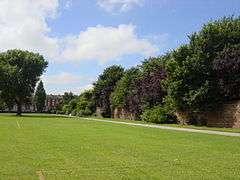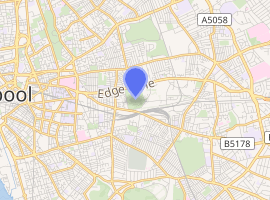Wavertree Botanic Gardens
Wavertree Botanic Gardens (formerly Wavertree Botanic Garden and Park) is an example of a mid 19th century public park in Liverpool. Originally constructed as a private botanic garden, it was taken over by Liverpool Corporation and expanded into a public park. The park is grade II listed, as is the curator's lodge on the site. Underneath the gardens are tunnels from the Littlewoods site, which were used as an air raid shelter during World War II.
| Wavertree Botanic Park and Gardens | |
|---|---|
 | |

| |
| Type | public |
| Location | Wavertree, Liverpool |
| Coordinates | 53.406°N 2.942°W |
| Created | 1846 |
| Operated by | Liverpool City Council |
| Status | Open all year |
History
William Roscoe and other botanists from the town founded Liverpool Botanic Garden in 1802, near Mount Pleasant.[1] In 1831, a new walled botanic garden was started at Wavertree, which was opened in 1836. The 4.5-hectare (11-acre) site was private for members of the society of botanists. Liverpool Corporation secured public right of access on two days a week in 1840 by paying one of the society's debts. The corporation took control from 1846. The gardens were expanded and landscaped throughout the 19th century along with adjoining properties that Liverpool Corporation owned. On 20 November 1940 a stray German bomb shattered the glass in the botanic glasshouse and the plants inside were shredded.[2]
On 22 August 2013 the botanic park and gardens were listed at Grade II* in the Register of Historic Parks and Gardens. In 1886 the International Exhibition of Navigation, Commerce and Industry was held there.[3]
Features
The gardens include a walled garden and ornamental carpet bedding, a play area and an ornamental fountain.[4]

Within the grounds is the curator's lodge, built in approximately 1836, when the garden was started. The Grade II listed building has been used since September 2013 as the Botanic Lodge Nursery for children.[5] It retains some of its original features.[6]
Underneath the botanic gardens is a tunnel which connects to the Littlewoods site. During World War II the 300-metre (980 ft) tunnel was used as an air raid shelter for Littlewoods workers, and is complete with contemporary graffiti.[7]
References
- Botanic Garden and Wavertree Park. Geograph Britain and Ireland. Retrieved 5 October 2011.
- Historic England. "Wavertree Botanic Garden and Park (1001538)". National Heritage List for England. Retrieved 2 September 2013.
- "Shipperies exhibition". Archived from the original on 26 October 2009. Retrieved 30 March 2012.
- "Wavertree Botanic Gardens". Liverpool City Council. Retrieved 21 March 2020.
- Jones Russell, Meredith (1 April 2014). "Young manager celebrates nursery 'outstanding'". Nursery World. Retrieved 21 March 2020.
- "How about this as a children's nursery?". Liverpool Echo. 30 August 2013. Retrieved 21 March 2020.
- Hadfield, Charlotte (13 July 2019). "The mysterious faces on the walls of a secret tunnel hidden underneath Liverpool park". Liverpool Echo. Retrieved 21 March 2020.
External links
| Wikimedia Commons has media related to Wavertree Botanic Gardens. |